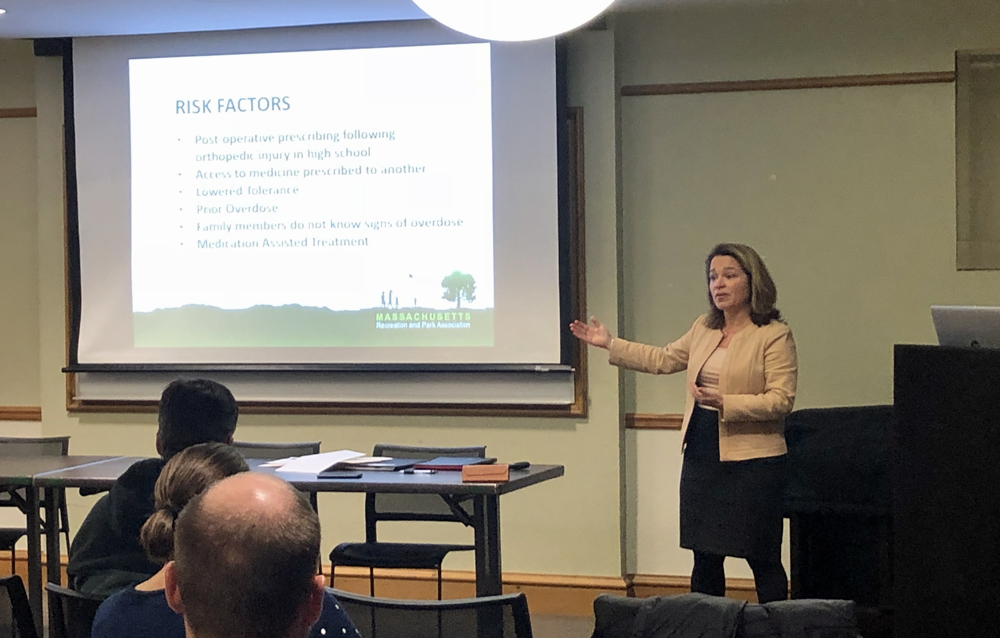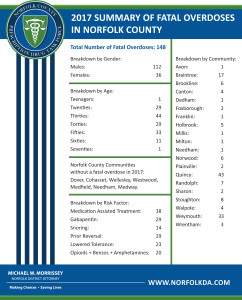ADA: Local partners, data review key to fighting substance abuse
By Jay Turner
Norfolk ADA Jennifer Rowe presents to a group of Mass. recreation professionals at the Canton Public Library.
Substance abuse continues to be at the root of societal problems in Norfolk County and many other locations across the commonwealth, but the secrets — to prevention, treatment and recovery — can be found right in one’s own backyard with the help of community partners and readily available data.
That, more than anything else, was the primary message behind Norfolk County Assistant District Attorney Jennifer Rowe’s presentation on substance use and overdose held at the Canton Public Library on Tuesday, February 13. Organized by Canton Deputy Recreation Director Nick Pirelli and attended by dozens of recreation professionals from across Massachusetts, the program highlighted the “multi-disciplinary, data-driven” approach to drug prevention currently being used in Norfolk County while exploring the potential role that parks and recreation departments and other municipal stakeholders can play in the fight to overcome substance abuse and save lives.
“You know the people, you know the places, and therefore you also know the problems,” emphasized Rowe at the start of her presentation. “That makes you best positioned in many instances to do this work. So many of our local police officers who are an important part of this effort grew up in the town that they proudly serve. They coached the kids that they’re rushing to save from overdose. They grew up with the parents and graduated from high school with them, and that’s a really different kind of place to be when you’re working as a public servant and you grew up in the town or you know the people and places very well.”
While emphasizing that every community is different and has its own set of challenges and resources, Rowe, a veteran prosecutor who now heads up Norfolk’s opiate overdose prevention unit, relayed her belief that substance abuse, although a massive problem, is very much a fixable one. And it starts, she said, with analyzing the data and coming to an understanding of risk factors and underlying causes.
Some of the most valuable data points, she said, come from sources such as the newly mandated Prescription Drug Monitoring program, the 911 emergency response system, and especially from local police reports, which are often “full of rich detail about how that beautiful young kid became entangled with addiction.”
While much of this information is limited to law enforcement agencies, Rowe noted that there are other data sources, such as the Youth Risk Behavior Surveys administered in all school districts, which are widely available and serve as valuable tools for local coalitions and community partners.
Rowe noted that Norfolk County is currently the only county in the commonwealth that regularly reviews fatal overdoses — a practice that began in 2013 with the awarding of a $250,000 federal grant. As a result, she said, those within the DA’s office now have a much clearer picture of the problems unique to this location — and they are rooted primarily in substance use, with the big three being opioid overdoses, impaired driving, and violence within relationships.
Specific to the opioid epidemic, Rowe said the “story” of Norfolk County, based on a review of the data, is that people are dying from medication prescribed to them and that, “by a mile, the greatest risk factor is post-operative prescribing following an orthopedic injury in high school.”
She added that the overdose victims are not current high school students, but most often people in their 20s and 30s who became hooked on opioids after being given a prescription for a legitimate medical reason. Common causes, according to Rowe, include sports injuries, motor vehicle accidents, and even dental surgeries. She noted that 75 percent of the overdose victims are male, and “virtually all” of them died in their homes.
“So when state police are responding to fatal overdoses,” said Rowe, “most of them are happening in an environment where they are with people who love them and who could save them if they recognized the symptoms of overdose, if they had other tools and information to help guide what they were doing and to be more vigilant about some of the [warning signs].”
Because Norfolk County has a firm grasp on the data surrounding overdose deaths, Rowe said the DA’s office has also been at the forefront of many successful awareness and prevention strategies, most of which, she said, are easily adaptable to other communities.
Examples of such strategies include outfitting police cruisers and fire engines with the overdose-reversal drug Naloxone; providing all individuals released from incarceration information on the dangers of lowered tolerance; and using money seized from drug dealers to train local pharmacists, prescribers, school nurses, and athletic trainers.
Rowe is also particularly proud of the Norfolk County Cares program, which distributes “care packages” to families of overdose patients that include treatment resources, a sharps disposal container, and information on obtaining Naloxone from the pharmacy. Rowe said a retired fire chief coordinates the program and responds within 48 hours of any successful overdose reversal to provide the family with a care package. To date, she said, they have not lost a single life at an address where they have delivered a Norfolk County Cares kit.
Perhaps the best news that Rowe had to report was that overdose deaths in the county, after climbing each year from 2013 to 2016, finally experienced a sizable decline over the past year, down from 174 to 148. She acknowledged that it is too soon to tell what caused this reduction, but she is confident that they are making progress and that a data-driven, multi-disciplinary effort can produce real results.
As for parks and recreation officials in particular, both Rowe and Pirelli agreed that they have an important role to play both in terms of prevention and recovery. Rowe encouraged attendees to freely borrow from programs and strategies being implemented across Norfolk County and also urged them to connect and collaborate with their local community substance abuse coalition (Canton’s coalition is the Canton Alliance Against Substance Abuse, or CAASA).
Pirelli suggested that Recreation departments consider adding programs specifically for those in recovery, including healing-based activities such as yoga. Rowe also stressed the value of recovery coaches and asked the audience to pay special attention to the vulnerable post-high school and post-collegiate populations.
“These are the kids who are struggling and who start to feel excluded [following an injury] and they don’t feel good about themselves and they take medication beyond the scope of that prescription,” she said. “And now we have a beautiful young kid who is struggling with an opioid addiction and it happens all the time. That’s our story. So think about that when you think about the kinds of kids that you have coming through your department and registering for programs. What an incredible outlet that could be for those kids.”
Short URL: https://www.thecantoncitizen.com/?p=38199











